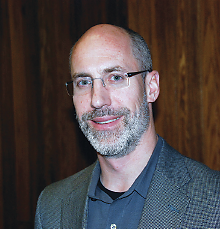Mystery Cells in Brain May Play Role in Several Diverse Disorders
Abstract
Oligodendrocyte progenitor cells exhibit remarkable homeostasis and strive to maintain their presence and function in response to internal, external perturbations in the central nervous system.
An “enigmatic” class of central nervous system cells discovered in the 1970s may one day lead researchers to a better understanding of the processes at work in conditions as diverse as multiple sclerosis, ALS, and traumatic brain injury.

Dwight Bergles, Ph.D., peers into the brains of living mice to track changes in oligodendrocyte progenitor cells over time.
Oligodendrocyte progenitor cells (OPCs), which give rise to the myelin-forming cells of the central nervous system, constitute 5 to 10 percent of all cells in the central nervous system, Dwight Bergles, Ph.D., a professor of neuroscience at Johns Hopkins University, said during the 10th Annual Amygdala, Stress, and PTSD Conference at the Uniformed Services University in Bethesda, Md., in April. The amygdala conference brings together clinicians and basic neuroscientists to expand cross-disciplinary understanding of mental health and illness.
OPCs (also termed “NG2+ cells” because they express the chondrotin sulfate proteoglycan NG2) comprise the majority of proliferating cells in the adult central nervous system, Bergles explained.
“In fact, 90 percent of all actively dividing cells in the adult CNS are these progenitor cells,” he said.
NG2+ cells appear throughout the adult CNS, where they are arranged like tiles on a floor, each non-overlapping cell equidistant from its neighbors—a pattern that Bergles explained is maintained because the cell’s radiating processes will retract if they come in contact with similar processes on another cell body. These cells appear in both white and gray matter and, unusual for brain cells, they continue to proliferate in the adult central nervous system.
Bergles studies NG2+ cells in mice by opening a window into their brains—literally. Using a laser, he either opens a hole in the mouse’s skull and places a glass cover over the opening or shaves the skull down paper thin. He uses two-photon microscopy to image the labeled OPCs repeatedly over many months with the brain intact and undamaged. By viewing the activity of individual cells overtime, Bergles has uncovered some unexpected properties of the cells.
“These cells move continuously, even migrating out of the microscope frame,” he said.
Studies show NG2+ cells will rapidly mobilize to replace oligodendrocytes when demyelination has taken place.
“When a cell dies, an immediate neighbor undergoes proliferation and migrates into the region previously occupied by the old, dead cell,” said Bergles. “They are highly dynamic, constantly reorganizing their positions and engaged in a ‘search function’ with their extended processes.”
In multiple sclerosis, there are a reduced number of OPCs, suggesting that something is impairing the cells’ ability to respond to demyelination.
In mouse models of ALS, Bergles found that while NG2+ cells exhibit enhanced proliferation and differentiation giving rise to new oligodendrocytes, the new cells fail to mature. The findings suggest that stimulating the production and maturation of oligodendrocyte progenitors might be beneficial for treating ALS.
Additional studies out of Bergles lab have also revealed the role OPCs play when responding to injury. Within a matter of hours, Bergles found OPCs will migrate to the site of injury, where they will they form a scar around the injury.
“They contribute to recovery by encapsulating and removing debris,” Bergles said. “That initiates a homeostatic response to replace the progenitors drawn into injury repair.”
As fruitful as his research has been so far, it has also produced two challenges, Bergles noted. First, he is only able to look at the outer cortex because going deeper into the brain would cause damage to the structures he is trying to observe. Even more daunting, perhaps, are the terabytes of data that such work produces and that demand more powerful and creative ways to store and analyze results, he said. ■



